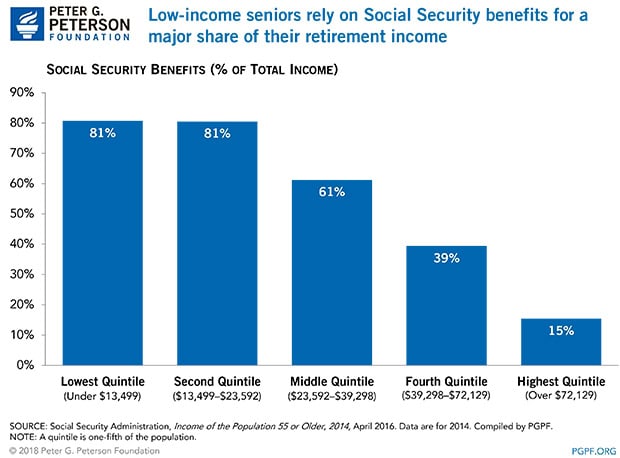Trustees Warn: Social Security’s Total Costs to Exceed Income for First Time Since 1982
Last month, the Social Security Trustees released a report on the health of the Social Security program’s finances. The report projects that in 2018 — for the first time since 1982 — the program’s total costs will exceed its total income.
Social Security is critical to the financial security of millions of Americans. The program provides financial assistance through two components — Old-Age and Survivors Insurance (OASI) and Disability Insurance (DI). OASI provides benefits for retired workers and their families, as well as survivors of deceased workers; DI provides benefits for disabled workers and their families.
Each component has its own “trust fund,” which is a mechanism to account for the receipts credited to the program and the benefits that have been paid. If trust fund receipts outstrip expenditures, the excess amount reduces the amount of borrowing necessary to finance other government activities; borrowing increases if trust fund receipts fall short of expenditures.
In their report, the Trustees find that:
- The Old-Age and Survivors Insurance trust fund will be depleted in 2034 and beneficiaries would be subject to a 23 percent reduction in benefits in that year.
- The financial outlook for OASI has deteriorated, as the trust fund will be depleted one year sooner than projected last year. In 2018, OASI spending is projected to be $854 billion, and revenues are projected to be $828 billion.
- The Disability Insurance trust fund is estimated to be depleted even sooner — in 2032; upon depletion, beneficiaries would be subject to a cut in benefits of 4 percent.
The Trustees emphasize the value of addressing reforms quickly:
“The Trustees recommend that lawmakers address the projected trust fund shortfalls in a timely way in order to phase in necessary changes gradually and give workers and beneficiaries time to adjust to them. Implementing changes sooner rather than later would allow more generations to share in the needed revenue increases or reductions in scheduled benefits and could preserve more trust fund reserves to help finance future benefits.”
Key Drivers of Insolvency
The aging of the population creates serious financial challenges for OASI. As baby boomers retire and life expectancy continues to increase, the number of Social Security beneficiaries is projected to climb sharply over the next several decades. By 2035, driven by the large growth in Americans age 65 and older, the total number of beneficiaries in the OASI program is projected to reach 75 million — about 40 percent more than in 2018.

Over the same period, the ratio of workers paying taxes to support each Social Security beneficiary will decline significantly from 3:1 today to 2:1. In 1970, that ratio was nearly 4:1.

The predictable, growing mismatch between the number of people paying into Social Security and the number receiving benefits will cause spending on the program to increase significantly faster than the amount of revenues collected to cover it.

Absent legislative action, once the trust fund is exhausted, Social Security will no longer be able to pay full benefits, and retirees could face an immediate 23 percent cut in their scheduled benefits. The DI trust fund is expected to be exhausted in 2032, at which point it will be able to pay 96 percent of its obligations (a 4 percent reduction). On a combined basis, cuts to the two programs would be 21 percent.

A reduction in benefits of that magnitude would impose huge burdens on all recipients, but especially low-income seniors because Social Security is a primary source of their income. Social Security provides more than 80 percent of the income of seniors in the bottom 40 percent of the income distribution (those with $23,592 or less in total income).

Trust Funds
The Social Security trust funds are used to conduct the financial operations of the OASI and DI programs. Income from taxes and other sources are credited to the funds and disbursements for benefits and administrative costs are counted against the funds’ balances. Although many believe that the existence of trust funds guarantees the sustainability of programs in the future, they are simply accounting mechanisms that are part of the way the federal government keeps its books.
The actual cash inflows and outflows of Social Security and other programs with trust funds are combined with the rest of the federal budget, and therefore surpluses in such programs have served to reduce the amount that the government has had to borrow for other programs. Trust funds do not hold their own outside investment assets; they are credited with special Treasury securities that effectively serve as IOUs from one part of the government to another.
Even though the Social Security trust funds are expected to have positive “balances” into the 2030s, beginning this year, the Treasury will have to borrow funds from the public to cover deficits in the program. Ultimately, trust fund income and outlays are not separate from the rest of the federal budget, and therefore the sustainability of trust fund programs, like Social Security, depends on the overall sustainability of the federal government.
Solutions
Long-term demographic trends are clear and their fiscal consequences are well known. The good news is that many policy solutions are available to address this predictable challenge and improve the financial outlook of Social Security. The Congressional Budget Office has published a report containing over 30 options for improving the long-term stability of the program, including reducing annual cost-of-living adjustments, increasing payroll taxes, lifting the income cap on payroll taxes, reducing initial benefits, and raising the retirement age. The Bipartisan Policy Center also published an extensive report outlining options for strengthening both Social Security and overall retirement security.
Social Security is an essential program that is relied upon by millions of American seniors. The sooner that we implement reforms, the easier it will be to protect this critical program.
Further Reading
Budget Basics: Unemployment Insurance Explained
The Unemployment Insurance program is a key counter-cyclical tool to help stabilize the economy and speed recovery during downturns or crises.
Can We Raise the Retirement Age and Protect Vulnerable Workers?
Raising the retirement age could harm workers who would be unable to delay retirement due to physically demanding occupations, disability, or job loss.
What Is SNAP? An Overview of the Largest Federal Anti-Hunger Program
SNAP has a positive effect on poverty and food insecurity, with a relatively small effect on the federal budget.


